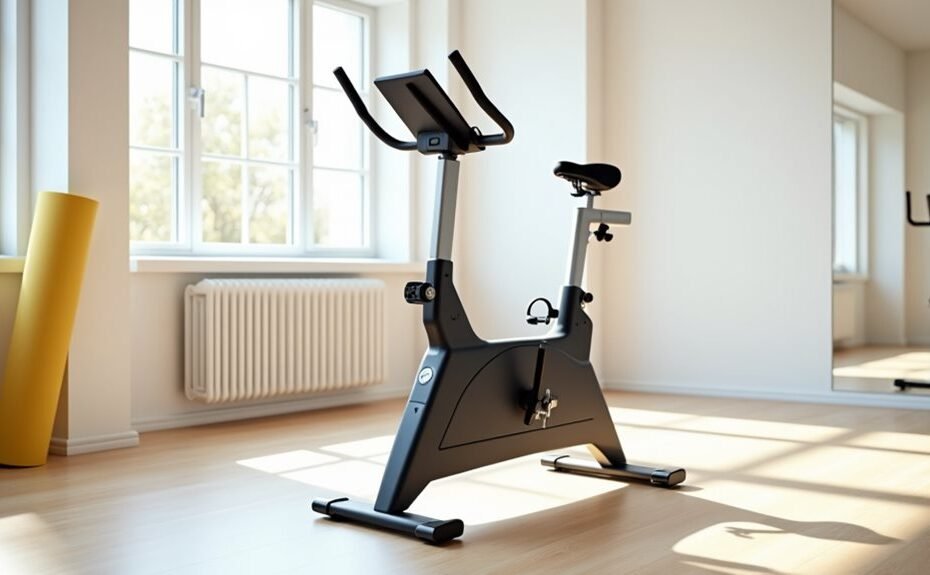I've explored dozens of entry-level static bikes over the years, and I've learned that finding the right one doesn't require breaking the bank. Whether you're just starting your fitness journey or looking to add cardio equipment to your home gym, understanding what separates a solid basic model from a questionable one can save you both money and frustration. While premium bikes boast impressive features, you'll be surprised to discover how today's entry-level options pack substantial value into their modest frames – and there's more to these affordable machines than meets the eye.
Key Takeaways
- Entry-level upright bikes typically feature basic LCD displays showing time, speed, and distance with 8-16 resistance levels.
- Folding upright bikes are ideal for beginners with limited space, offering essential features and compact storage solutions.
- Basic magnetic resistance systems provide quiet operation and sufficient challenge for newcomers to static cycling.
- Budget-friendly models usually include standard pedal cages, adjustable seats, and weight capacity up to 265 pounds.
- Simple belt drive systems require minimal maintenance and deliver smooth pedaling motion suitable for beginners.
Understanding Static Bike Categories
When diving into the world of static bikes, you'll encounter four main categories that serve different workout needs and preferences. Let me break them down for you – no fluff, just facts.
Indoor cycling bikes are your classic gym warriors. Think SoulCycle vibes: narrow seat, forward-leaning position, and those distinctive clip-in pedals. I recommend these if you're chasing that authentic road bike experience. Air bikes feature a noisy fan system that creates resistance while you pedal.
Upright bikes are your space-saving champions. They'll keep your posture vertical with pedals right under your seat. Trust me, your core will thank you – these bikes engage those upper body muscles like nobody's business. For those tight on space, folding upright bikes offer an excellent storage solution.
Now, recumbent bikes are the comfort kings. You're basically pedaling from a chair (with back support!). I always suggest these for seniors or anyone nursing an injury. They're gentle but don't mistake that for ineffective.
Essential Features To Look For
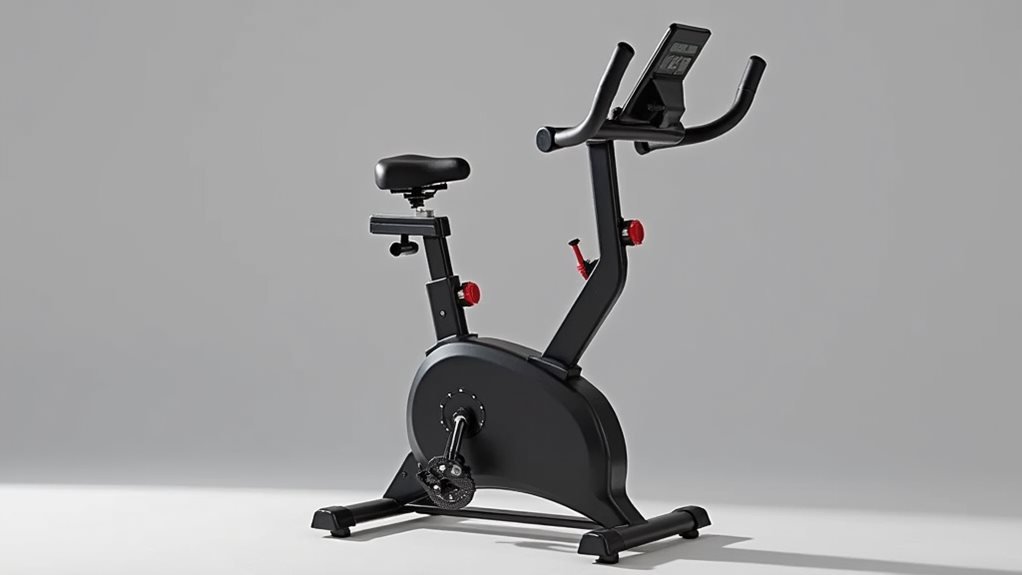
Before investing in an entry-level static bike, I want you to focus on four core features that'll make or break your workout experience.
First, don't compromise on adjustability. You'll need a bike that adapts to your body – look for adjustable seat height, handlebars that move, and a saddle that slides forward and back. Trust me, your back will thank you. A proper fit is crucial, as many bikes can support up to 330 pounds. Basic bikes often lack performance metrics like cadence and heart rate monitoring that could help optimize your workouts.
Second, resistance matters more than you'd think. I recommend magnetic resistance with at least 24 levels. It's smoother than friction-based systems and won't wake your neighbors at 5 AM. Make sure there's an emergency brake – you'll need it during those sprint intervals.
Third, get a decent display. You don't need a fancy touchscreen, but you do need basic metrics like speed, distance, and resistance level. If it connects to fitness apps, even better – motivation comes easier when you're tracking progress.
Comfort and Ergonomic Design
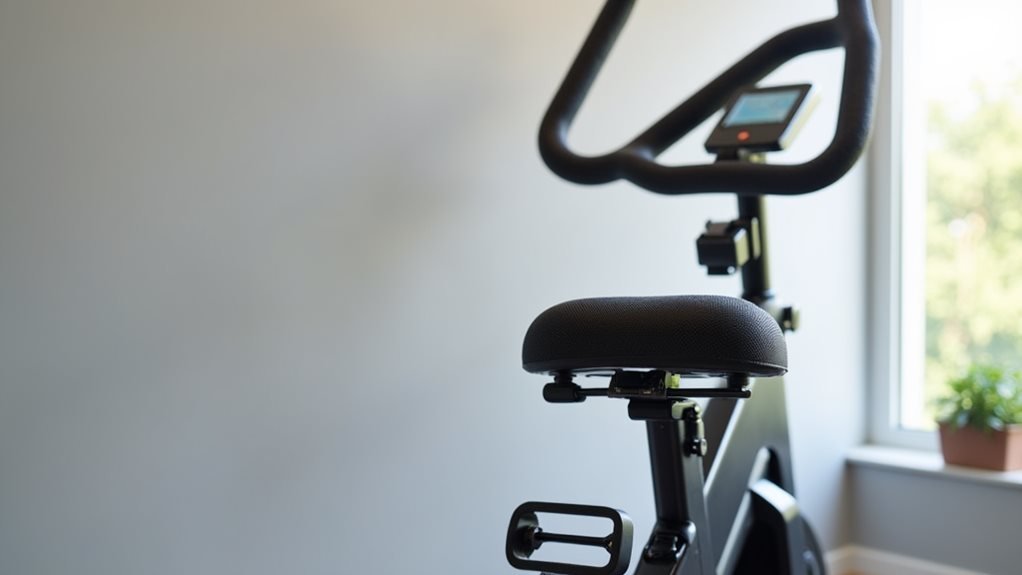
After hours of riding, comfort becomes the deciding factor between a bike you love and one that gathers dust. I'll tell you straight up – adjustability is everything. Look for bikes that offer extensive seat adjustments (height and fore/aft positioning) to accommodate riders from 5'1" to 6'5". Many entry-level bikes now feature magnetic resistance systems for smooth operation. Trust me, your lower back will thank you. The Domyos Basic Exercise Bike 100 offers chain-driven drivetrain performance at an affordable price point.
Don't skimp on handlebar options either. I always recommend models with multiple hand positions and adjustable heights. It's not just about comfort; it's about maintaining proper form through those grueling sessions.
And let's talk pedals – you'll want secure cages or dual-sided options compatible with both sneakers and SPD-cleats.
Here's what separates the winners from the dust-collectors:
- Extra-large cushioned seats (your tailbone matters)
- Emergency brakes (because safety first)
- Transport wheels (because you're not deadlifting your bike across the room)
For maximum convenience, grab a model with a device holder – you'll want your training apps within reach. Remember, the best entry-level bike isn't just about resistance levels; it's about creating a comfortable, sustainable riding experience that keeps you coming back.
Resistance and Drive Systems
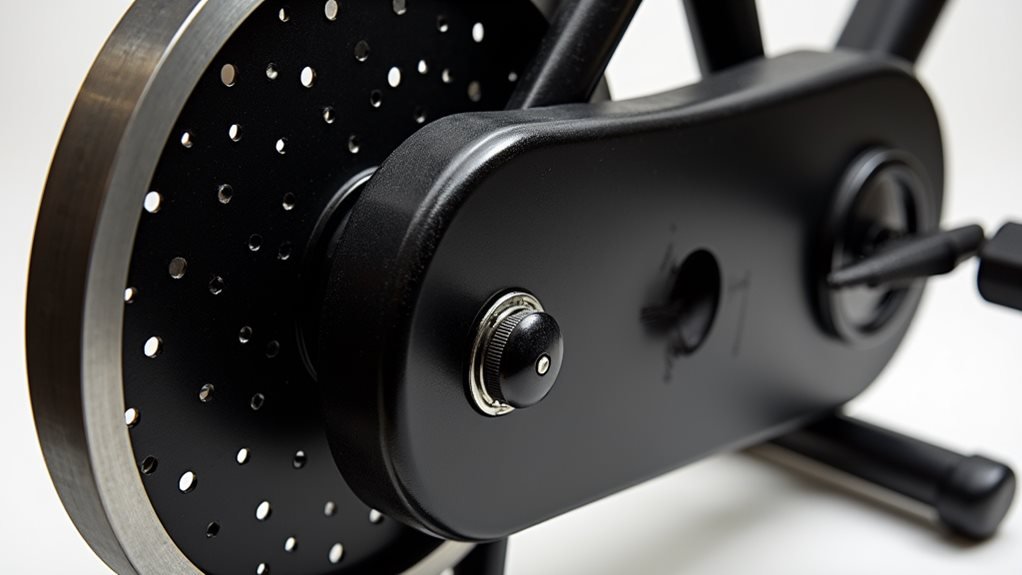
The heart of any static bike lies in its resistance and drive systems. Let me break down your options, because choosing the right combination will make or break your indoor cycling experience.
I'll be direct: magnetic resistance is your best bet for entry-level bikes. It's whisper-quiet, maintenance-free, and offers plenty of resistance levels to challenge you. Sure, friction resistance is cheaper, but those pads wear out faster than your New Year's resolutions. Trust me, you don't want that headache. The YOSUDA bike uses micro-adjustable friction resistance that gives precise control over your workout intensity. Due to ongoing improvements, some features may be temporarily unavailable while we upgrade our systems.
For drive systems, here's the deal: belt drives are superior to chains, period. They're quieter, smoother, and won't leave grease stains on your carpet. Yes, chain drives are cheaper, but they'll need regular maintenance that'll drive you nuts.
Don't forget about the flywheel – it's not just a fancy wheel. A heavier flywheel (think 30+ pounds) gives you that real road-bike feel. I recommend looking for digital resistance controls too. They're easier to adjust mid-workout than those clunky manual knobs, and you won't have to take your hands off the handlebars when you're pushing your limits.
Technology Integration Options
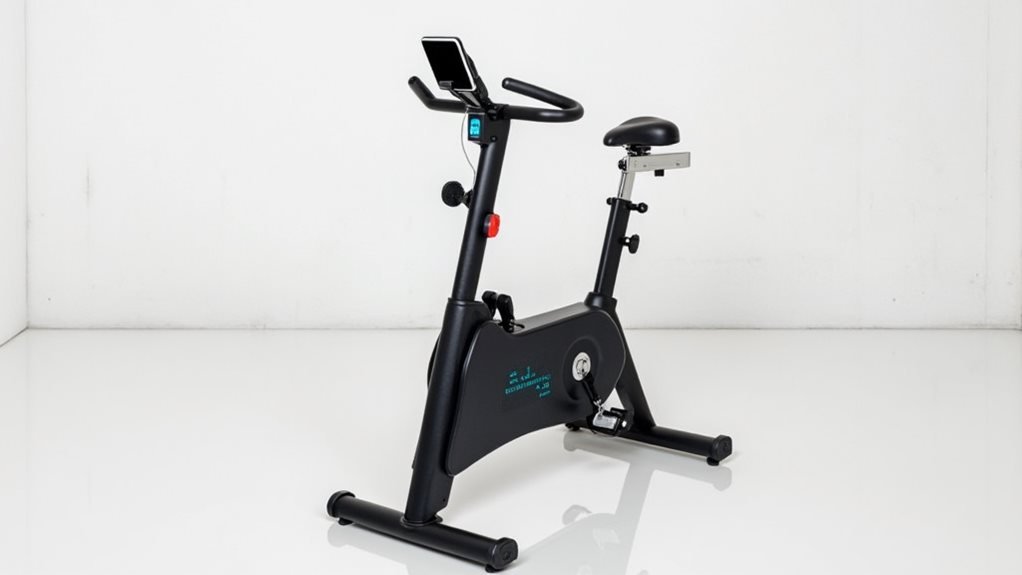
Modern entry-level static bikes pack impressive tech features that were once reserved for premium models. I've seen massive improvements in connectivity options, with most bikes now offering Bluetooth integration for seamless app connections. You'll get real-time metrics streamed directly to your favorite training platforms like Zwift, making indoor workouts more engaging and data-driven. While not as advanced as the electromagnetic resistance systems found in high-end smart bikes, entry-level models still provide effective resistance control. Many static bikes can support riders up to 297 pounds capacity, making them accessible to a wide range of users.
- Basic models now include smartphone holders and simple LCD displays for essential stats like speed, distance, and heart rate.
- Mid-range options offer tablet compatibility and ANT+ connectivity for using multiple devices simultaneously.
- Advanced entry-level bikes feature built-in workout tracking and automated resistance control.
I recommend focusing on bikes with at least basic Bluetooth connectivity – it's a game-changer for motivation and progress tracking. The ability to connect to training apps transforms a simple static bike into an interactive fitness tool. While you won't get the fancy touchscreens of premium models, today's entry-level bikes offer enough tech integration to keep your workouts challenging and engaging. Trust me, these basic connectivity features will serve you well as you build your indoor training routine.
Space and Storage Requirements
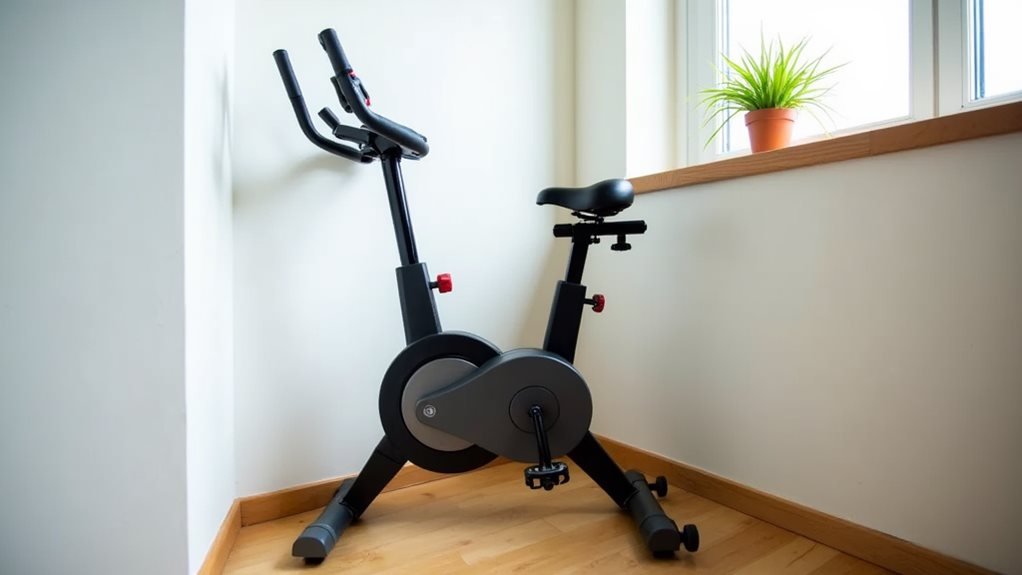
Finding adequate space for an entry-level static bike requires careful planning, even though these models typically need less than 2' x 4' of floor space. I recommend clearing about a foot on each side to prevent that cramped, claustrophobic feeling you'll hate during intense workouts. Trust me, you'll want that extra breathing room.
You'll need roughly six feet by four feet total when you factor in your movement zone. Don't just think floor space – consider height too. I've seen too many people forget about ceiling fans and light fixtures until it's too late.
And here's a pro tip: these bikes are heavy beasts. My LifeSpan C5i weighs over 92 pounds, so pick your spot wisely.
Set yourself up for success by placing your bike near a power outlet and in a well-ventilated area. I always tell my clients to keep a small table nearby for essentials – water bottle, towel, and snacks. And please, don't put it on thick carpet. Use a solid mat instead – it'll improve stability and reduce noise. Your downstairs neighbors will thank you.
Best Value For Your Budget
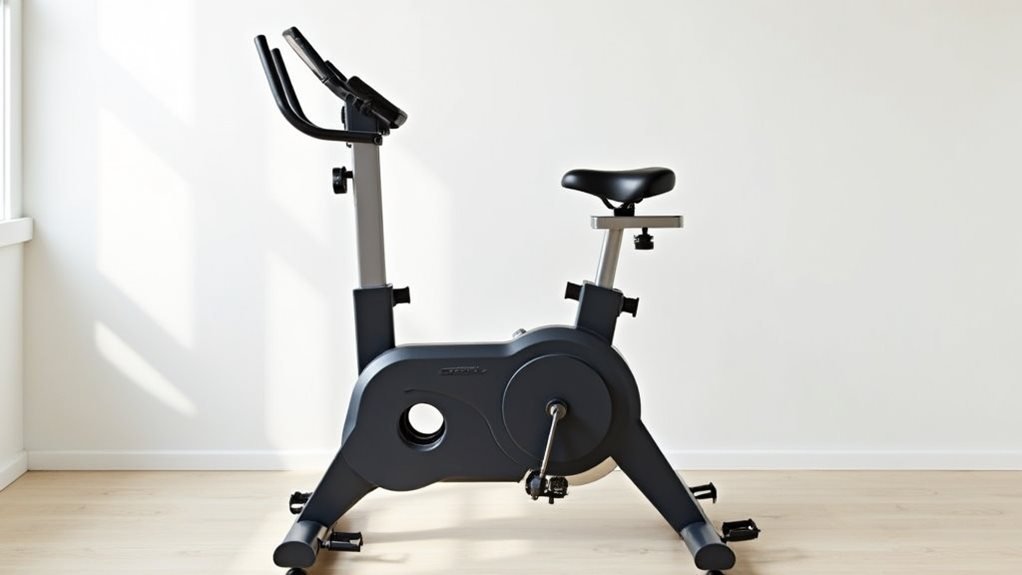
Value takes on new meaning when shopping for entry-level static bikes, where prices typically range from $150 to $300. I've found that budget-friendly options like the Domyos Basic Exercise Bike 100 and Yosuda Indoor Cycling Bike deliver impressive functionality without breaking the bank. These machines nail the essentials: solid construction, adjustable resistance, and comfortable riding positions.
- The Domyos Basic Exercise Bike 100 ($150) proves you don't need fancy features for an effective workout – its 12kg flywheel and straightforward design get the job done.
- Yosuda's Indoor Cycling Bike brings magnetic resistance and premium comfort without subscription fees, supporting users up to 300 lbs.
- The Cyclace Indoor Exercise Bike ($199) hits the sweet spot with its quiet belt drive and detailed LCD monitoring system.
I'll be blunt: spending more doesn't always mean better value. The Sunny Health and Fitness Recumbent Bike, priced under $300, delivers comfort and quality for beginners without unnecessary bells and whistles. Focus on core features like adjustability, resistance levels, and build quality – they'll matter more than flashy screens or app integrations in your daily workouts.
Frequently Asked Questions
How Long Should a Beginner's Static Bike Workout Session Last?
You'll want to start with just 20 minutes at first. I recommend gradually building up your workout time to 35 minutes as your fitness improves over several weeks.
Can Using a Static Bike Help With Knee Rehabilitation?
Yes, I can confirm that static bikes are excellent for knee rehabilitation. They'll help reduce your pain, improve joint mobility, and strengthen muscles while being low-impact on your knees.
Should I Wear Cycling Shorts When Using an Indoor Bike?
Studies show cycling shorts reduce saddle discomfort by up to 80%. I'd definitely recommend wearing them for indoor cycling – they'll keep you dry, prevent chafing, and make your rides much more comfortable.
How Often Should the Static Bike Be Maintained or Serviced?
I recommend daily wipes after use, weekly hardware checks, and monthly deep cleaning. Don't skip the basic daily maintenance – it'll save you from bigger problems and costly repairs later.
Can Static Bikes Be Used Safely During Pregnancy?
I'm thrilled to tell you that static bikes are incredibly safe during pregnancy! I recommend them because they're low-impact, stable, and adjustable. Just get your doctor's approval and listen to your body.
